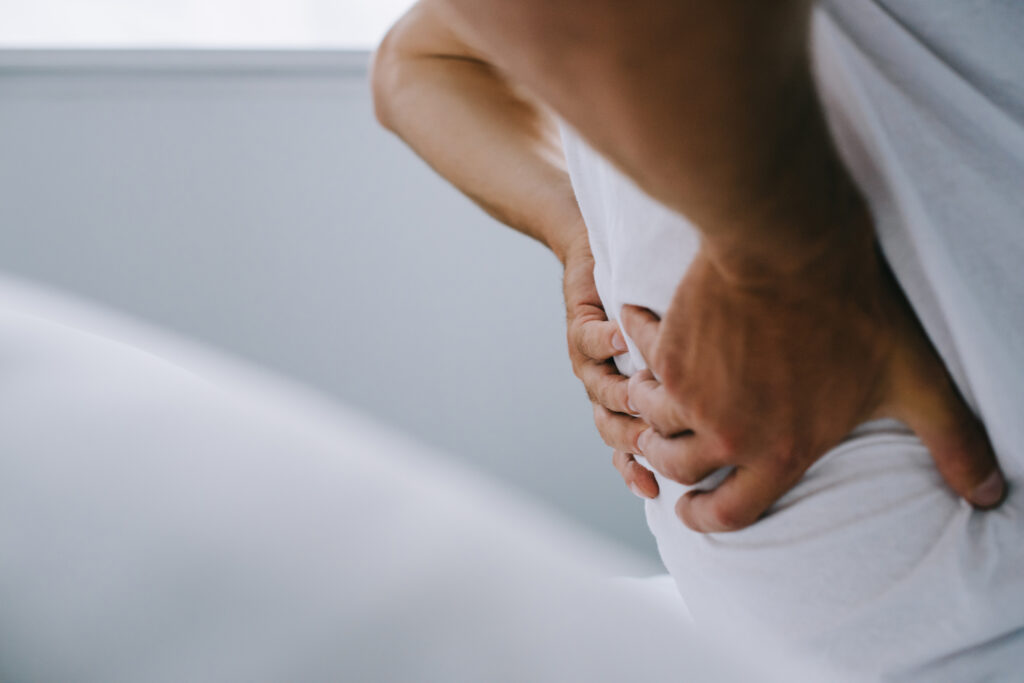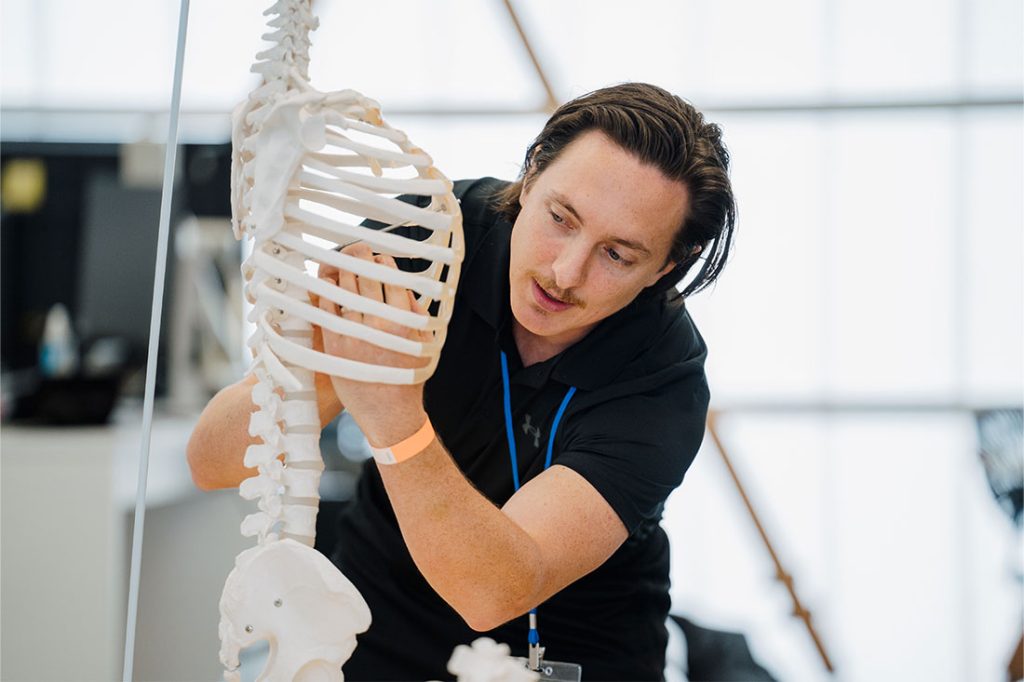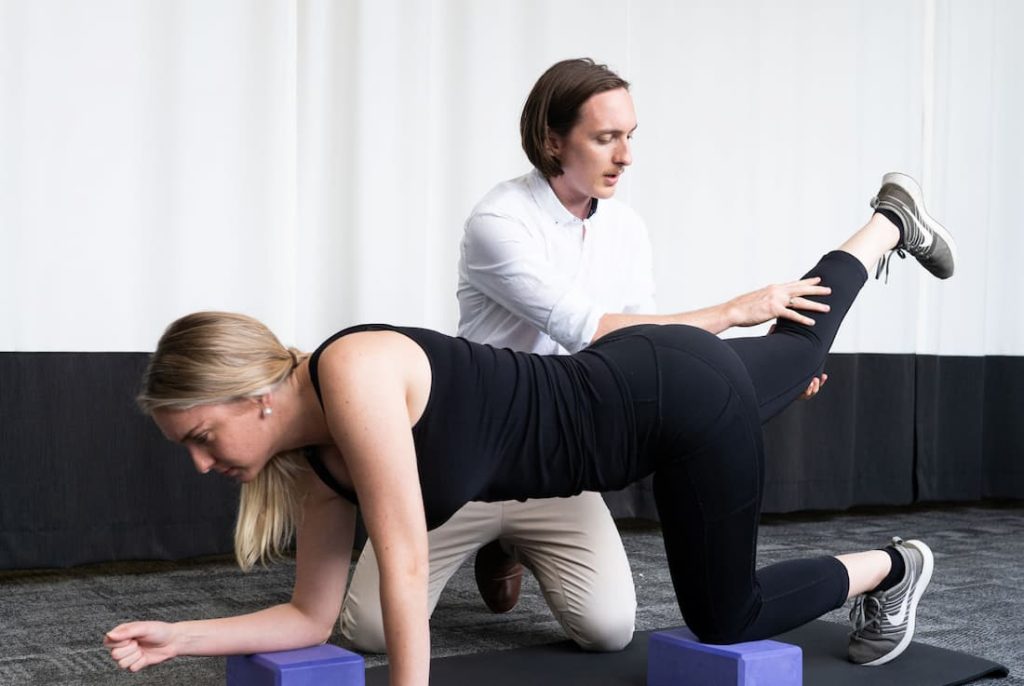“Why am I injury prone?” It’s a question we get asked often. And, if you’re an athlete or someone who exercises regularly, it might seem normal to get injured now and then. But what if you’re not very active, and still find yourself dealing with injury after injury? It’s easy to assume it’s just bad luck, but the truth is, some people do tend to get hurt more easily than others.
So, what does it actually mean to be injury-prone? And more importantly, what can you do about it?
Research shows there are several specific, identifiable reasons that can increase your risk of injury. These are things like overtraining, poor technique, past injuries, and even your body’s unique physical makeup.
In addition to that, what I’ve learned through treating countless clients is that your fitness level directly impacts your injury risk. Those with lower cardiorespiratory or muscular endurance levels actually face a greater risk of injury and re-injury. More importantly, how you move matters just as much as how fit you are.
In this blog, we’ll answer the question explore the common causes behind recurring injuries and explain how exercise physiology, a science-backed approach to movement and recovery, can help break the cycle.
What Does It Mean to Be Injury-Prone?
The term “injury-prone” is defined as being “frequently injured”. But it’s a lot more than how often you get hurt. It combines genetic traits, body structure, gender, disease states, exercise habits, nutrient deficiencies, environment, risk-taking behaviour, and previous injury history.
If you recognise that you’re injury-prone, you’re not admitting weakness. You’re accepting a physical reality that needs special attention and is the first step in understanding how your body works and what it needs to stay healthy, active, and pain-free.
The Two Main Types of Injuries: Acute vs. Overuse
Injuries typically fall into two categories: acute and overuse.
- Acute injuries happen suddenly. like a fall, twist, or collision. These can result in things like sprains, fractures, muscle tears, or dislocations.
- Overuse injuries build up gradually over time. They’re the result of repeated stress on the same area without enough rest or recovery. These injuries may take days or even weeks to surface, but once they do, they can be just as disruptive, if not more so, than an acute injury.
Studies have identified that the majority of injuries, particularly in active individuals, result from accumulated microtrauma, small stresses that add up when the body isn’t given enough time to adapt. Athletes often face this problem when they train hard without adequate rest, but it can happen to anyone who repeats the same motions without proper support or recovery.
Common Signs You Might Be Injury-Prone
If any of the following sound familiar, you may be more injury-prone than most people:
- You had more injuries as a child compared to your peers
- The same body part seems to always be injured or in pain
- There’s a pattern of similar injuries in your family
- You experience joint pain or aches on a daily basis
- You seem to get hurt doing simple activities that others manage easily
The Science Behind Frequent Injuries
Getting injured isn’t always about one wrong move. Often, it’s your body’s way of saying it’s overwhelmed. Behind every injury is a complex chain reaction involving your muscles, nervous system, hormones, and even your mental state. Understanding how these systems work and where they can break down helps explain why some people seem to get hurt more often than others.

How the Body Reacts to Stress, Fatigue, and Poor Mechanics
Your body is constantly working to maintain balance, especially under physical stress. When you’re faced with a challenge, like a tough workout or an unexpected movement, your autonomic nervous system responds by releasing hormones that raise your heart rate and blood pressure to help you perform. This is a normal and helpful response in the short term.
But when stress becomes ongoing or unmanaged, this same system can become overloaded. The result? A body that’s more vulnerable to injuries.
Mental health plays a big role here, too. Studies show that athletes who felt anxious before a sports season were 2.3 times more likely to get injured. Additionally, anxiety or depression has been linked to physical injuries too. This mind-body connection impacts anyone pushing their limits, physically or mentally.
Fatigue makes the problem worse. Without enough sleep or recovery, your body can’t repair itself properly. Instead of building strength, your tissues slowly break down, making injury not just possible, but likely.
Why Am I Injury Prone? The Common Causes Behind Repeated Injuries
If you feel like you’re stuck in a cycle of injuries, there are often specific, preventable reasons why you might be getting hurt over and over again. Certain physiological weaknesses can quietly increase your injury risk over time. These vulnerabilities create a weak foundation that can make injuries a recurring issue.
These underlying causes often hide in the details of how you move, train, and recover.
1. Poor Biomechanics and Movement Patterns
One of the biggest culprits behind recurring injuries is poor movement mechanics. When your body moves inefficiently, due to improper form, joint instability, or poor posture, your muscles, tendons, and joints are forced to compensate in ways they weren’t designed for. Over time, this leads to uneven stress on tissues and, ultimately, injury.
2. Muscle Imbalances and Weaknesses
Your muscles work in teams, especially around the joints. When certain muscle groups are too strong or too weak compared to their partners, your movement becomes less stable and makes you more injury-prone.
For example, studies have shown that weak hip abductors and external rotators are closely linked with lower leg injuries. Common patterns in injured athletes include quadriceps dominance (overusing the quads compared to hamstrings) and plantar flexor dominance (overreliance on calf muscles). These imbalances put extra strain on the knees, ankles, and lower back.
3. Inadequate Warm-Ups and Cool-Downs
Warming up and cooling down might seem basic, but they play a powerful role in injury prevention. Skipping these routines leaves your muscles less prepared for activity and more prone to strain. A proper warm-up and stretching can prevent the risk of muscle injury by more than 30%.
4. Training Errors and Overtraining
Success doesn’t lie in how hard you train, but in how smart you train. Overtraining occurs when you increase intensity, duration, or frequency too quickly, without enough time for your body to recover. When rest takes a backseat, your body’s repair systems can’t keep up, leading to fatigue, inflammation, and breakdown of tissues.
Repetitive strain injuries, joint pain, and muscle soreness that doesn’t go away are common signs that your training routine might be pushing you too far. For those who aren’t as active, this might indicate underlying biomechanical issues, poor posture during daily tasks, or a lack of foundational strength and mobility that’s putting excess strain on certain areas of the body.
5. Previous Injury History and Poor Rehabilitation
Perhaps the strongest predictor of future injury? A past one. Previous injuries can cause subtle changes in how your body moves, even after the pain subsides. These changes, known as disruptions in the kinematic chain, can increase your risk of re-injury, long after it has healed.
If you’ve had a previous injury, you are 2–3 times more likely to reinjure the same area, especially if you return to activity too soon or didn’t complete a thorough rehabilitation process.

When Anatomy Works Against You: Structural and Genetic Factors
Training mistakes and poor movement patterns aren’t the only factors that are to blame, it’s your anatomy and genetics too. While training errors and poor movement do habits play a big role in injury risk, certain people are naturally more vulnerable because of how their bodies are built and how their genes are wired.
However, understanding that your anatomy and genes may be working against you isn’t a setback. Learning about these natural factors helps you create specific strategies that work with your body’s unique blueprint.
Hyperflexibility or Hyperlaxity
Some individuals are born with more flexible joints, a condition known as hypermobility or hyperlaxity. This is the classic “double-jointed” trait, where joints bend beyond their normal range due to loose ligaments and connective tissues. It affects around 10–25% of children and is more common in females.
While hypermobility might seem like an advantage, especially in dance, gymnastics, or yoga, it actually increases your injury risk. Athletes with hypermobility are:
- 2.5 times more likely to sustain knee injuries in general sports
- 4.5 times more likely to get injured in contact sports
- They also face a much higher risk of re-injury after procedures like ACL surgery. 24.4% compared to just 7.7% in non-hypermobile individuals.
Skeletal Alignment and Structural Anomalies
The way your bones and joints are aligned affects how force travels through your body when you move. Even people with healthy knees can experience pain or injury due to variations elsewhere, like in the hips. A common example is femoroacetabular impingement, where the shape of the hip joint limits movement and leads to joint stress.
When bones or joints are even slightly out of alignment, your body compensates. Over time, these compensation patterns overload certain tissues and set the stage for chronic injuries.
Family History and Genetic Predispositions
Being “injury-prone” often runs in the family. If you have a blood relative who tore their ACL, you’re four times more likely to tear yours too. This pattern shows up in other injuries as well – studies of twins suggest ACL injuries are about 69% inherited.
Specific genes play vital roles in injury risk:
- Collagen genes (COL1A1, COL5A1): Affect tendon and ligament strength
- GDF5 gene: Influences bone, muscle, and tendon growth/maintenance
- AMPD1 gene: Impacts muscle function during exercise
Interestingly, people with the TT variant of the COL1A1 gene (found in only 5% of the population) are much less likely to suffer tendon or ligament injuries.
Lifestyle and Environmental Factors That Contribute to Injuries
Your everyday habits, environment, and recovery play a major role too. They can either support your body or slowly wear it down.
Sedentary Habits and Poor Desk Ergonomics
Modern life has become increasingly sedentary. Many people now spend the majority of their day sitting, especially at work. In Australia, office workers spend over 75% of their work hours seated, averaging around 5 hours of sitting a day. This prolonged inactivity puts strain on key areas like the neck, shoulders, and lower back.
Even regular gym sessions after work aren’t enough to undo the damage of poor ergonomics. Simple changes can make a big difference, like adjusting your chair and monitor height, using a standing desk, or taking movement breaks every 20–30 minutes.
Inadequate Sleep and Recovery
Sleep is when your body heals, grows stronger, and prepares for the next day. Yet many people sacrifice it without realising the consequences. Individuals who consistently get less than 7 hours of sleep for two weeks are 1.7 times more likely to get injured in some way.
Why? Because deep sleep is when your body releases growth hormone, a key player in muscle repair and recovery. Without it, tissues don’t recover properly, and you’re more vulnerable to strains, sprains, and fatigue-related injuries.
Poor Nutrition and Hydration
What you eat and drink fuels your body’s performance, and its ability to stay injury-free. Hydration, in particular, is important.
Even slight dehydration can impair muscle function, reduce coordination, and increase the likelihood of cramping or soft tissue injuries. Without enough fluids, your body struggles to regulate temperature, deliver nutrients, and flush out waste, key processes for healthy muscle recovery.
Nutrition also plays a critical role. Diets lacking in protein, essential fats, vitamins (like D and C), and minerals (like calcium and magnesium) can slow healing and increase inflammation. Poor eating habits may weaken your immune system, reduce muscle repair, and leave joints more vulnerable to strain.
The Psychological Side of Being Injury-Prone
The connection between mind and body plays a vital role in determining your chances of getting injured. Your psychological state can affect your injury risk just as much as your physical condition.
Stress and Its Physical Impact on the Body
Stress can trigger a cascade of physical reactions that make your body more vulnerable to injury. Under stress, your nervous system activates the fight-or-flight response. Muscles tighten, reflexes change, and your coordination suffers. This combination increases the chance of poor movement, slower reactions, and painful mistakes.
Stress affects attention too. It narrows your focus and increases self-consciousness, disrupting the fluid, automatic movements needed for safe performance.
Long-term stress also creates a state of chronic tension in the body. That constant physical strain raises the risk of muscle fatigue, joint dysfunction, and overuse injuries. One study found that a majority of injuries were linked to psychological stress and how people responded to it.
Fear of Movement and Re-Injury
Sometimes, what holds people back after an injury isn’t the pain; it’s the fear of pain coming back. This fear, known as kinesiophobia, affects more than half of the people with ongoing or recurring injuries. Even when the body is physically ready, the mind may hesitate.
This fear shows up most strongly:
- Right after an injury occurs
- When returning to normal activity or sport after rehab
As a result, many people avoid using the injured area fully, which weakens the muscles further and increases the chance of re-injury. It becomes a vicious cycle: the fear leads to weakness, the weakness increases risk, and each new injury confirms the fear.

Exercise Physiology: What Is It and Why Does It Matter?
Exercise physiology is a science dedicated to how the body responds, adapts, and heals through movement. This specialised field studies the immediate effects of physical activity as well as the long-term changes that occur with consistent exercise.
At its core, exercise physiology looks at how your muscles, heart, lungs, and nervous system react and improve when you move. Exercise physiologists assess and apply this knowledge to help individuals build strength, improve cardiovascular fitness, enhance performance, and boost functional capacity.
Exercise physiologists also focus on how exercise influences chronic conditions and disease progression. From managing diabetes and heart disease to supporting mental health and recovery from injury, these professionals use tailored exercise programs as powerful therapeutic tools.
How To Reduce Your Injury Risk With Exercise Physiology
Exercise physiology offers a structured, science-backed approach to reducing your risk of injury by addressing the root causes before they become a problem. Here’s how it works:
Detailed Assessments and Movement Screens
Everybody moves differently. That’s why exercise physiologists begin with comprehensive assessments and movement screenings to identify poor biomechanics, muscle imbalances, or limitations in mobility and strength. These insights form the foundation for an effective injury-prevention plan.
Correcting Movement Patterns
Once problem areas are identified, the focus shifts to correcting faulty movement patterns that often lead to chronic injuries. Whether it’s how you squat, run, lift, or sit at your desk, small adjustments to your form can make a big difference in reducing wear and tear on your joints and muscles.
Improving Flexibility and Strength
Stiff, tight muscles and weak stabilisers are a recipe for injury. Exercise physiology uses targeted strength and mobility work to enhance range of motion, reinforce posture, and support joint health, especially in commonly neglected areas like the hips, shoulders, and core.
Targeting Major Muscle Groups
Injury prevention requires building a strong, balanced foundation. Programs focus on developing key muscle groups that support everyday movement and athletic performance, helping you stay strong and resilient.
Monitoring Fatigue and Recovery
Overtraining is one of the most common causes of injury. Exercise physiologists track your workload, fatigue, and recovery patterns to make sure your body is adapting, not breaking down. This ensures you’re progressing safely and sustainably.
Tailored Exercise Prescription Based on Your Unique Needs
There’s no one-size-fits-all approach. Whether you’re returning from injury, managing a health condition, or looking to stay injury-free, your program is built specifically for you, based on your goals, capabilities, and lifestyle.
Education and Coaching to Promote Long-Term Change
Lasting results come from knowledge and consistency. Exercise physiologists don’t just guide you through workouts, they equip you with the tools, techniques, and mindset to move smarter for life. With the right support and education, injury prevention becomes part of your everyday routine.
Learn More: What Is Exercise Physiology? A Beginner’s Guide to Movement & Health

The Respire Difference
At Respire, I go beyond traditional injury prevention methods by addressing the underlying patterns that many traditional approaches overlook. I take a deeper look at your biomechanics, breathing mechanics, and personal history to understand why injuries happen, so we can help you prevent them in a way that’s truly effective and lasting.
Understanding the Left AIC Pattern
One of the key patterns we assess is the Left Anterior Interior Chain (Left AIC), a common asymmetry that contributes to many pain and injury issues.
In simple terms, this pattern occurs when your left pelvis rotates forward, causing your body to shift rightward. To keep you facing forward, your upper spine counter-rotates to the left. This tug-of-war creates a twisted alignment that places excessive strain on specific muscles, like the left diaphragm, psoas, rectus femoris, iliacus, and TFL. Over time, this leads to poor movement mechanics, reduced stability, and increased injury risk.
Breathing & The Link To Injury
Breathing matters more than you think. How you breathe plays a major role in pain relief, core control, and nervous system regulation. Breathing wrong, such as shallow, rapid chest breathing, can increase muscle tension, reduce oxygen delivery to tissues, and disrupt your body’s natural ability to manage stress and recover.
This not only makes pain harder to control but also weakens your core stability, leaving your spine and joints more vulnerable to injury. Learning to breathe deeply and rhythmically helps calm your nervous system, relax tight muscles, and support better movement patterns – key factors in preventing injuries before they happen.
A Trauma-Informed Approach
Pain isn’t just physical, and neither is healing. Many people carry the lasting effects of emotional trauma, which can keep their body stuck in a state of high alert. This ongoing stress response often alters posture, restricts breathing, and changes the way you move—all without you realising it.
At Respire, we take a trauma-informed and whole-person approach. That means we consider:
- Biological factors like posture, muscle imbalances, and movement patterns
- Psychological factors including fear of movement, anxiety, and pain beliefs
- Social and lifestyle factors such as past trauma, work stress, and support systems
Taking the First Step
The frustration of constant injuries doesn’t have to define your story. The fundamental truth is that your injury patterns aren’t random, and they’re certainly not permanent. Reasons for being injury prone can range widely, from genetics and poor movement mechanics to muscle imbalances, training mistakes, mental blocks, and lifestyle choices.
What often goes unnoticed is how deeply connected your breathing patterns, recovery habits, and overall physiology are in influencing your injury risk and healing too. When you address these factors systematically, rather than just chasing individual symptoms, everything changes.
No one should have to suffer through ongoing pain and setbacks. As an accredited exercise physiologist on the Gold Coast, my approach brings clarity and tailored strategies that work with your unique body. Together, we can break the cycle and set you on the path to lasting, injury-free movement and better health.


